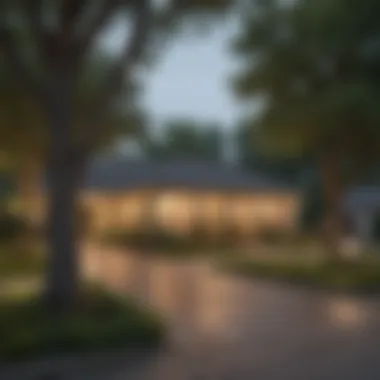Top Neighborhoods to Live in Austin: In-Depth Review


Intro
Austin, Texas, is a vibrant city known for its diverse neighborhoods, each offering a unique blend of lifestyle, amenities, and culture. The decision on where to live can significantly impact one's quality of life. This article aims to unravel the complexities of different areas within Austin. From historic districts with charm to modern communities that emphasize convenience, we will explore various factors that make these neighborhoods desirable.
In our analysis, we will dive into key elements such as housing options, local amenities, demographics, and historical significance that contribute to the overall character of each neighborhood. By understanding these aspects, prospective residents can make informed decisions tailored to their individual needs and preferences.
Exquisite Architectural Designs
Austin's architectural landscape is as diverse as its residents. The city's neighborhoods feature a range of designs, from contemporary styles to historic homes, presenting an array of choices for potential homeowners.
Unique Home Features
Many neighborhoods boast distinctive home features that reflect Austin's artistic flair. For instance, homes in the South Congress area often showcase colorful facades and eclectic designs. Conversely, neighborhoods like Old West Austin are known for their stately historic homes with elegant woodwork and traditional craftsmanship. This architectural variety not only enhances the visual appeal of the area but also provides potential buyers options that suit different tastes and lifestyle preferences.
Historical Significance
From the Victorian structures in the Clarksville area to the mid-century modern homes in Brentwood, historical significance plays a crucial role in Austin's real estate identity. Many neighborhoods are registered as historic districts, preserving their architectural integrity while fostering a sense of community pride. Living in these areas offers more than just a home; it provides a connection to Austin's rich past and cultural heritage.
"Architecture is a visual art, and the buildings speak for themselves." – Julia Morgan
Housing Markets and Trends
Navigating the housing market in Austin requires understanding trends specific to each neighborhood. Prices may vary dramatically depending on the area due to factors like amenities, schools, and public transportation access. For example, neighborhoods like Downtown Austin have experienced rapid gentrification, leading to a surge in housing costs. In contrast, areas such as East Austin offer more affordable options but are gaining popularity due to their vibrant arts scene and cultural diversity.
Comparison of Housing Options
Potential homebuyers should consider several key factors:
- Market Prices: Researching average home prices can help set realistic expectations.
- Rental Opportunities: Many neighborhoods provide lucrative rental prospects for investors or those not ready to purchase.
- School Districts: Quality of local schools influences property values, making family-friendly areas highly sought after.
Understanding these components can help individuals find a suitable living environment that fits their lifestyle.
Epilogue
Austin offers a variety of neighborhoods, each presenting its distinct advantages and lifestyle options. This comprehensive analysis aims to guide prospective residents through their decision-making journey by highlighting key factors influencing neighborhood appeal. By examining the architectural designs, historical significance, and housing trends, we hope to equip individuals with the knowledge necessary to make well-informed choices about their future homes in this dynamic city.
Prelude
Deciding to relocate involves more than simply packing boxes and moving furniture. It requires a deep understanding of the environment that you will be entering. With Austin's rapid growth and diverse culture, this city presents a unique landscape for potential residents. The choice of neighborhood can significantly influence one's lifestyle, work-life balance, and overall satisfaction. Therefore, evaluating the key elements of each area can help individuals make informed decisions about where to call home.
This article aims to dissect the neighborhoods within Austin, highlighting their specific attributes. It emphasizes essential factors such as cost of living, proximity to amenities, and quality of schools. These elements are crucial for anyone looking to ensure that their new living space not only meets their needs but also aligns with their personal values and lifestyle.
In this exploration, various neighborhoods will be characterized, revealing their charm and challenges. From the vibrant streets of Downtown Austin to the serene atmosphere of Westlake Hills, each area offers its own distinct flavor. Readers will find insights into community engagement and the potential for personal fulfillment in these neighborhoods.
Austin's real estate market is competitive, making it imperative to have a thorough understanding of what each neighborhood has to offer. By navigating this article, readers can equip themselves with knowledge that goes beyond surface-level information. The detailed analysis provided herein will ensure that potential residents make choices in line with their aspirations and financial situations.
Overview of Austin
Austin, Texas is a city known for its unique blend of culture, economy, and vibrant communities. Understanding Austin's overview is vital for potential residents who seek the best area to live. The city offers a dynamic lifestyle that attracts diverse populations, including professionals, artists, and families. Exploring the fundamentals sets the stage for making informed choices about living in this eclectic metropolis.
City Demographics
Austin has experienced rapid growth in the last few decades. As of recent census estimates, the population exceeds one million. The demographic profile is varied, with a significant presence of young professionals and families.
- Age Distribution: A high percentage of the population is between 25 and 34 years old. This age group contributes to the city's energetic atmosphere and demand for community services.
- Ethnic Diversity: Austin is also quite diverse in terms of ethnicity. Approximately 45% of the residents identify as non-white. This diversity enriches the local culture and influences the culinary scene, festivals, and art.
- Educational Attainment: A large portion of the residents hold at least a bachelor’s degree. This educational background correlates with the city's growth in high-tech industries and innovation.
Neighborhood choices often reflect these demographics. Areas like East Austin are popular among younger residents, while neighborhoods such as Westlake appeal more to families seeking top-rated schools.
Cultural Significance
Austin is regarded as the “Live Music Capital of the World.” Renowned for its vibrant artistic scene, it hosts numerous music festivals, including South by Southwest (SXSW) and Austin City Limits Music Festival. The city's cultural significance extends beyond music. Historical landmarks and venues reflect its rich heritage. Here are some key points:
- Artistic Expression: The local art scene is thriving with galleries, murals, and public art installations. Residents often engage in artistic activities, fostering a community spirit.
- Culinary Landscape: Austin’s culinary scene mirrors its cultural diversity. From food trucks to high-end restaurants, the city caters to various tastes, with a focus on Tex-Mex and barbecue cuisine.
- Community Events: Regular events, such as the Pecan Street Festival and various craft fairs, bring neighborhoods together, enhancing the sense of community.


“Austin’s cultural landscape is a tapestry woven from its diverse backgrounds, making it a point of interest not only for residents but also for visitors.”
Overall, understanding the demographics and cultural significance of Austin enlightens potential residents on what they can expect, thus allowing them to choose neighborhoods that align with their lifestyle and values.
Factors to Consider When Choosing a Neighborhood
Choosing a neighborhood in Austin, or any city for that matter, is a significant decision that impacts daily life. Each neighborhood carries its unique attributes. Prospective residents need to weigh several factors to make an informed choice. Elements such as cost of living, quality of schools, accessibility and transport options, employment opportunities, and safety are essential in this evaluation. Understanding these criteria helps in aligning personal preferences with practical needs.
Cost of Living
The cost of living is one of the most critical factors to consider when selecting a neighborhood. This includes housing prices, utilities, groceries, and local taxes. Each Austin area has its distinct pricing structure. For example, Downtown Austin may have higher rent due to its proximity to businesses and cultural venues. On the other hand, neighborhoods like Allandale might offer more affordable housing options. Evaluating income level against expected expenses assists potential residents in determining what they can realistically afford while maintaining a desirable lifestyle.
Quality of Schools
For families, the quality of schools is often a top priority. A neighborhood may be appealing due to its academic achievements, extracurricular offerings, and overall student support. Neighborhoods such as Westlake Hills are known for their top-rated schools. This factor is vital for parents seeking the best education for their children. Quality schools often reflect the overall community engagement and can influence property values. Researching school ratings and visiting schools can provide insight into educational opportunities in various areas.
Accessibility and Transportation
Accessibility impacts daily commuting and overall convenience. Austin's diverse neighborhoods offer different modes of transportation. Areas like Downtown have easy access to public transport, making them suitable for those who prefer not to drive. In contrast, neighborhoods like North Loop may require reliance on personal vehicles but offer a more eclectic lifestyle. Evaluating commute times and local public transport options is essential for determining the feasibility of daily activities and the potential stress of travel.
Employment Opportunities
The availability of jobs is a crucial consideration when choosing a neighborhood. Economic growth in various sectors, such as technology and healthcare in Austin, has influenced where people choose to live. For instance, areas with clusters of tech firms may attract individuals looking for convenient commutes. Understanding local job markets and employment trends helps potential residents comprehend how job security and career advancement align with neighborhood choice.
Safety and Crime Rates
Safety is an undeniable concern for anyone considering a new home. Evaluating crime rates in each neighborhood is essential for feeling secure in a community. Some areas are known for their lower crime statistics, attracting families and young professionals alike. Reliable sources for this information include local law enforcement agencies and community forums. Ensuring safety enhances peace of mind and overall community satisfaction.
"Safety is not just about numbers; it’s about the feeling of community and security residents experience."
In summary, factors such as cost of living, school quality, accessibility, job opportunities, and safety should play a crucial role in one’s decision-making process when selecting a neighborhood in Austin. Each resident’s situation is unique, and understanding these elements can greatly aid in finding the most suitable area to call home.
Neighborhoods in Austin
Choosing a neighborhood in Austin is not just a matter of finding a place to live; it involves discovering a community that aligns with one's lifestyle, preferences, and values. Each area offers distinct characteristics that appeal to different groups. To navigate this landscape effectively, potential residents should consider various critical factors including cultural vibes, amenities, and housing options.
The importance of neighborhoods in Austin lies in their ability to shape one’s daily experience. Various neighborhoods cater to specific demographics, whether it be families, young professionals, or retirees. Each neighborhood presents its own opportunities and challenges, making it essential for individuals to understand the unique elements of each area before making a commitment.
Downtown Austin
Downtown Austin is a microcosm of the vibrant life that the city has to offer. It encapsulates the bustling environment filled with entertainment, dining, and cultural institutions. The appeal of this area can be dissected into several key characteristics.
Vibrant Nightlife
The vibrant nightlife in Downtown Austin is one of its most significant draws. There are numerous bars, clubs, and live music venues. This atmosphere attracts people seeking an active social life and cultural richness. The unique feature of this nightlife is the diversity it offers—from laid-back acoustic sets to dynamic dance floors, the experience can cater to various tastes. However, this vibrancy also comes with drawbacks; noise and crowding can be substantial concerns.
Proximity to Workspaces
The proximity to major workspaces adds another layer of appeal. Many companies have headquarters or offices in the downtown area, making commuting convenient for professionals. This characteristic is beneficial for those looking to reduce travel time. However, as demand grows, office spaces may become more congested and living costs may escalate.
Cultural Attractions
The array of cultural attractions further solidifies Downtown Austin's position as a prime location. Museums, theaters, and music festivals provide a rich cultural tapestry that residents can enjoy. This aspect is beneficial to those who value arts and culture. Nevertheless, the influx of tourists can sometimes overshadow the experience for locals.
South Congress
South Congress offers a distinct charm that resonates with residents who appreciate eclectic shopping and dining experiences. This neighborhood has a unique character that contributes to its desirability.
Quaint Shops and Dining
The area is lined with quaint shops and diverse dining options. These local businesses create a unique shopping experience where one can often find handmade goods. A key characteristic is the support of local artisans. Shopping here supports the community spirit. However, due to its popularity, some establishments may face long wait times.
Community Vibe


The community vibe in South Congress is prominent. The residents often engage in neighborhood events and festivities, enhancing social connections. The friendly atmosphere invites newcomers to integrate seamlessly. Still, as the neighborhood grows, maintaining this tight-knit feel can become a challenge.
Historic Landmarks
Historic landmarks add to the area’s appeal, offering a glimpse into Austin's past. Places like the iconic Hotel San Jose serve as reminders of the city’s history. This connection to history makes the neighborhood attractive to those who appreciate heritage. Nevertheless, preservation efforts can sometimes limit new developments.
East Austin
East Austin is gaining recognition for its artistic and progressive environment. The changing landscape here is noteworthy.
Emerging Art Scene
The emerging art scene is dynamic and reflects the creativity of the residents. New galleries and public art installations showcase local talent. This is a beneficial aspect for artists and art enthusiasts alike. However, rapid development may displace established studios and galleries.
Affordable Housing
Affordable housing options remain a strength in East Austin. Compared to other areas, it provides opportunities for young professionals and families. Many find this appealing, given the rising costs in the greater Austin region. Yet, as demand increases, this affordability may diminish.
Urban Development
Urban development is ongoing, transforming the neighborhood. New businesses and residential spaces are being constructed. This aspect indicates growth and opportunity. However, such developments can disrupt the existing community and culture, leading to concerns among long-time residents.
Westlake Hills
Westlake Hills embodies luxury and tranquility, appealing to families and professionals seeking a more serene environment.
Scenic Views
The neighborhood is known for its scenic views of the Texas Hill Country. Residents often enjoy picturesque landscapes that enhance their living experience. This characteristic adds to the allure, especially for nature lovers. However, the premium price attached to these views presents a barrier for many.
Luxury Living
Luxury living is a defining factor in Westlake Hills. High-end homes and properties attract affluent individuals. The exclusivity is appealing to those who prioritize high-quality living. Still, amenities may be less accessible compared to more central neighborhoods.
Top-rated Schools
The presence of top-rated schools makes this area particularly attractive to families. Excellent educational opportunities are crucial for many parents. This aspect is a solid advantage for the neighborhood. However, the pressure to maintain these standards can be significant, influencing school district policies.
North Loop
The North Loop neighborhood provides a blend of artistic and modern living, appealing to a diverse crowd.
Eclectic Atmosphere
North Loop is characterized by its eclectic atmosphere that showcases a mixture of vintage shops and contemporary art spaces. This personality makes it appealing for those who appreciate uniqueness. However, the increasing popularity of the area may lead to commercial uniformity over time.
Local Coffee Shops
Local coffee shops contribute to the neighborhood's charm, serving as cozy meeting places for residents. These cafes foster community connection. However, as chains become more prevalent, independent shops may struggle to maintain their clientele.
Community Events
Community events are a highlight in North Loop. Neighborhood gatherings and markets offer spaces for social interaction. This feature enhances the sense of belonging among residents. On the downside, planning and executing these events can require extensive effort from residents.
Allandale
Allandale is recognized for its family-friendly environment, making it a welcoming option for those looking to settle down.
Family-friendly Environment
The family-friendly environment in Allandale is a significant factor for many residents. The presence of parks and family-oriented activities supports this character. This aspect is beneficial for households with children. However, as families migrate to the area, competition for housing rises.
Local Parks


Local parks are integral to the neighborhood's appeal. They provide essential recreational spaces for residents, allowing for outdoor activities and a sense of community. This feature enhances overall quality of life. However, maintenance of these parks can sometimes be challenging, leading to concerns about upkeep.
Residential Appeal
Allandale has a strong residential appeal due to its tree-lined streets and well-maintained homes. This visual aspect is attractive to potential homeowners. However, the market's competitiveness may limit options for new buyers.
Through examining these neighborhoods in Austin, prospective residents can make informed decisions. This understanding aids in finding a place that aligns with lifestyle preferences and personal values.
Comparative Analysis of Neighborhoods
Evaluating neighborhoods based solely on surface characteristics can be misleading. A detailed comparative analysis of neighborhoods reveals the nuances that can significantly impact the quality of life for prospective residents. Understanding these differences is essential for making informed choices about where to live in Austin. Each neighborhood offers a unique set of benefits and possible drawbacks that cater to varying lifestyles, preferences, and financial situations.
This section aims to dissect the elements of cost of living and community engagement within neighborhoods to guide future residents in their decision-making process. Factors such as housing prices, local amenities, social opportunities, and quality of services create a picture that goes beyond mere appearances. By considering these factors together, potential residents can gain a better understanding of which area in Austin may best fit their needs, desires, and expectations.
Cost and Living Space
When examining the cost associated with living spaces in Austin, it becomes clear that affordability varies from one neighborhood to another. Each area has a distinct price range that corresponds to its amenities, demand, and overall desirability. Considering these differences is paramount, particularly for families, young professionals, or retirees seeking budget-friendly options.
For instance, Downtown Austin boasts a vibrant lifestyle, but high demand drives rental and purchasing prices up. Contrastingly, areas like North Loop and Allandale often provide more budget-conscious options while maintaining appealing living environments.
Here are some factors to consider:
- Median Home Prices: Neighborhoods such as Westlake Hills often feature higher median home prices due to their luxury offerings and top-rated schools.
- Rental Rates: The rental market is broad across the city, with some neighborhoods providing affordable rates, while others may present steep prices influenced by their proximity to urban centers.
- Living Space: Sizes of living spaces can differ significantly. Some neighborhoods might offer larger homes for families, while others may favor smaller apartment living, which suits individuals or couples.
Ultimately, understanding the cost and living space in various neighborhoods enables prospective residents to make prudent financial commitments while considering their needs.
Community Engagement and Activities
Community engagement plays a pivotal role in shaping one’s experience in a neighborhood. Engaging with local events, activities, and organizations fosters a sense of belonging and enhances overall satisfaction. An evaluative look at the communal aspects of each neighborhood reveals varying opportunities for residents to connect with one another.
In several areas of Austin, community activities are abundant, reflecting the city’s diverse culture and interests. For example:
- Local Events: Neighborhood parks frequently host events that encourage participation from families and residents. Such events range from arts and crafts fairs to seasonal festivals.
- Social Groups: Joining community clubs or organizations can offer individuals and families avenues for interaction and support, enriching their local experience.
- Volunteer Opportunities: Many neighborhoods advocate for volunteer programs, inviting residents to help with local charities or community services, thereby strengthening communal ties.
Engagement through activities and events is not just about enjoyment; it strengthens community resilience and fosters connections among residents. Hence, it's crucial for future Austin residents to consider how community engagement can enhance their living experience in specific neighborhoods.
Understanding local engagement and cost of living factors is essential for anyone looking to settle in Austin. These insights promote informed decisions and align living arrangements with personal circumstances.
Closure
Understanding the varied neighborhoods within Austin is essential for anyone considering relocating to this vibrant city. In this article, we explored the unique characteristics of different areas, from the cultural vibes of East Austin to the scenic luxury of Westlake Hills. Each neighborhood offers its own blend of amenities, lifestyle choices, and housing options.
Ultimately, your choice of neighborhood in Austin should align with personal priorities and lifestyle preferences. Key factors such as community engagement, available resources, and accessibility play significant roles in ensuring a satisfying living experience. Whether you prioritize proximity to work, family-friendly environments, or vibrant nightlife, Austin has options to meet various needs.
Final Thoughts on Living in Austin
Living in Austin brings not only a sense of place but also opportunities for personal growth. The city is ever-evolving, reflecting changes in demographics and cultural significance. When weighing your options, it’s imperative to consider your compatibility with local communities. Many neighborhoods foster a welcoming atmosphere with activities and events that promote engagement.
In addition, the quality of life in Austin shines through its green spaces, educational institutions, and local economies. Residents often find themselves participating in community initiatives that further enhance the living experience. Moreover, the food scene, arts, and outdoor activities contribute to a fulfilling lifestyle.
It is advisable to explore various neighborhoods first-hand to feel the differences. Engaging with local residents can provide insights that guide better choices. Overall, feeling at home in Austin often depends on how well you align your lifestyle with the right neighborhood.
"Selecting the right place to live is about more than housing. It’s about finding where you truly belong."
Resources and Further Reading
In the context of exploring the best neighborhoods in Austin, having access to reliable resources and further reading materials can greatly enhance one’s understanding. This section sheds light on the importance of well-curated resources that detail the city's intricacies and neighborhoods.
A solid base of information empowers prospective residents. It ensures that the choices they make align well with their preferences. Resources provide facts about various neighborhoods, such as demographic data, cultural aspects, market trends, and local amenities.
Benefits of Resources
- In-depth Knowledge: Reading various materials, such as neighborhood guides or forums, offers nuanced insights that may not emerge in a brief overview. These resources cover specific aspects like cost of living averages and school rating systems.
- Comparative Analysis: With multiple sources, readers can compare neighborhoods effectively. Insightful databases or articles from websites like Wikipedia or Britannica can help weigh pros and cons of different areas.
- Community Input: Platforms such as Reddit or Facebook facilitate discussions among current residents. Engaging with these communities offers first-hand experiences and personal anecdotes which are invaluable when considering a move.
"Access to diverse perspectives can lead to a more rounded understanding of a neighborhood's character and livability."
Considerations When Using Resources
- Credibility: Validate sources to ensure the information provided is accurate. Rely on established platforms and peer-reviewed articles.
- Updates: The real estate market fluctuates. It's important to check the date of the last update on any resource to avoid outdated facts.
- Targeted Research: Depending on your priorities—be it schools, safety, or transportation—focus on resources that address those specific needs.
By utilizing a mix of resources, potential residents can obtain a comprehensive view of what life could be like in Austin's many neighborhoods. Making informed decisions based on thorough research ultimately leads to more satisfactory living experiences.















